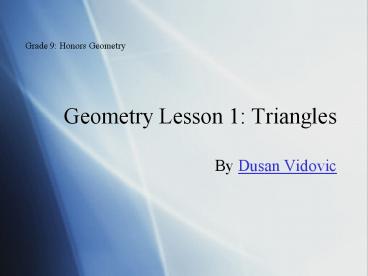Geometry Lesson 1: Triangles - PowerPoint PPT Presentation
1 / 22
Title:
Geometry Lesson 1: Triangles
Description:
Obtuse Triangle. It has one internal angle larger than 90 . Acute Triangle ... http://en.wikipedia.org/wiki/Image:Triangle.Obtuse.svg ... – PowerPoint PPT presentation
Number of Views:2289
Avg rating:3.0/5.0
Title: Geometry Lesson 1: Triangles
1
Geometry Lesson 1 Triangles
Grade 9 Honors Geometry
- By Dusan Vidovic
2
Purpose of the Lesson
- Addressing 4th Indiana Academic Standard for
Geometry. - Identify and describe triangles.
- Define, identify, and construct altitudes,
medians, and angle bisectors. - Identify congruent triangles.
3
But First, What Is a Triangle?
- A polygon with 3 sides which are straight
line segments. - Base
- 2 legs
- Any 3 non-collinear points determine a
triangle. - Vertices
- 3 angles summing up to 180 degrees.
4
Triangle Classification
- According to the lengths of their sides.
- Isosceles
- Scalene
- Equilateral
- Equiangular
- According to the size of their largest internal
angle. - Right
- Obtuse
- Acute
5
Isosceles Triangle
- At least two sides are of equal length.
- It also has two congruent angles.
6
Scalene Triangle
- All sides have different lengths.
- The internal angles are all different.
7
Equilateral/Equiangular Triangle
- All sides are of equal length.
- All its internal angles are equal.
- An equilateral triangle is also equiangular.
8
Right Triangle
- It has one 90 internal angle (a right angle).
- The side opposite to the right angle is the
hypotenuse (the longest side in the right
triangle). - The other two sides are the legs.
- Opposite
- Adjacent
9
Obtuse Triangle
- It has one internal angle larger than 90.
10
Acute Triangle
- It has internal angles that are all smaller than
90 (three acute angles).
11
Triangle Properties
- All of the previous triangles that we have seen
have the following properties - Medians
- Altitudes
- Angle Bisectors
- The hyperlink on each term will lead you to more
information including formulas which are not
covered in today's lecture.
12
Median
- It is a line joining a vertex on one angle to the
midpoint of the opposite side. - It divides the triangle into two parts of equal
area. - Every triangle has three medians which intersect
in the triangle's center of mass.
13
Altitude
- It is a straight line through a vertex and
perpendicular to (i.e. forming a right angle
with) the opposite side. - The intersection between the (extended) side and
the altitude is called the foot of the altitude.
This opposite side is called the base of the
altitude. - The length of the altitude is the distance
between the base and the vertex.
14
Angle Bisector
- The (interior) bisector of an angle is the line
segment that divides the angle into two equal
parts.
15
Triangle Congruence
- Two triangles are congruent if their
corresponding sides and angles are equal. - Usually it is sufficient to establish the
equality of three corresponding parts and use one
of the following results to conclude the
congruence of the two triangles. - SAS - SSS ASA AAS
16
Side Angle Side
- Two triangles are congruent if a pair of
corresponding sides and the included angle are
equal.
17
Side Side - Side
- Two triangles are congruent if their
corresponding sides are equal.
18
Angle Side - Angle
- Two triangles are congruent if a pair of
corresponding angles and the included side are
equal.
19
Angle Angle - Side
- Two triangles are congruent if two angles and a
non - included side - of one triangle are congruent to two angles and
the corresponding - non-included side of another triangle.
20
Important Remarks
- An equilateral triangle is also an isosceles
triangle, but not all isosceles triangles are
equilateral triangles. - An equilateral triangle is an acute triangle, but
not all acute triangles are equilateral
triangles. - AAA (Angle-Angle-Angle) is not a method of
proving triangle congruence because it says
nothing about the size of the two triangles and
hence shows only similarity and not congruence. - While the AAS (Angle-Angle-Side) condition
guarantees congruence, SSA (Side-Side-Angle) does
not. WHY????????? - More information on triangles can be found at
Math World.
21
Sources
- http//mathworld.wolfram.com/Triangle.html
- http//www.indianastandards.org/standard.asp?Subje
ctmathGradeGStandard4 - http//library.thinkquest.org/20991/geo/ctri.html
SAS - Pictures
- http//ostermiller.org/calc/triangle.png
- http//academics.sru.edu/ModLang/French/Activities
/french20photo20gallery/paris20-20rose/glass2
0pyramid20-20louvre.jpg - http//www.pbs.org/wgbh/nova/pyramid/geometry/imag
es/scaleintro.jpeg - http//en.wikipedia.org/wiki/ImageTriangle.Equila
teral.svg - http//en.wikipedia.org/wiki/ImageTriangle.Isosce
les.svg - http//en.wikipedia.org/wiki/ImageTriangle.Scalen
e.svg - http//en.wikipedia.org/wiki/ImageTriangle.Right.
svg - http//en.wikipedia.org/wiki/ImageTriangle.Obtuse
.svg - http//en.wikipedia.org/wiki/ImageTriangle.Acute.
svg - http//en.wikipedia.org/wiki/ImageTriangle.Centro
id.svg - http//en.wikipedia.org/wiki/ImageTriangle.Orthoc
enter.svg - http//library.thinkquest.org/20991/geo/ctri.html
SAS
22
THE END
- Homework
- Study the material presented today.
- Do Pg. 49, numbers 3,5,7,9,11,12, and 14 for
Monday. - Have a great weekend!!!































